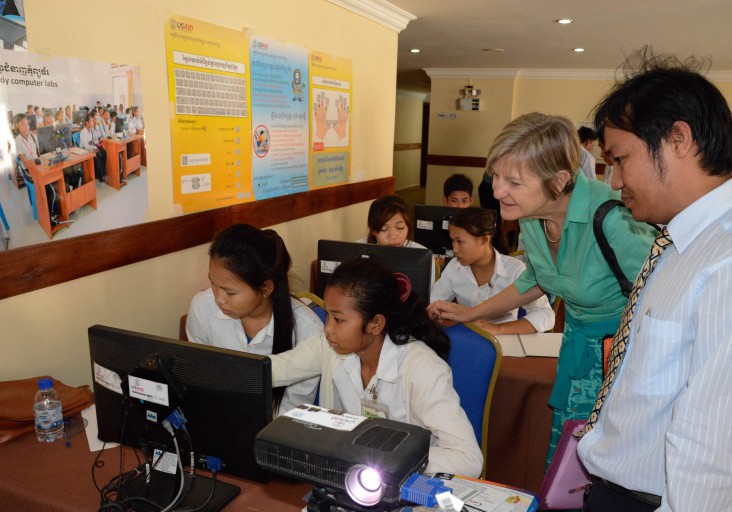
Your Excellency Im Koch, Secretary of State, Ministry of Education Youth and Sport
Excellencies, distinguished guests, ladies and gentlemen
It is my great pleasure to welcome all of you today to this workshop. Giving every Cambodian child the opportunity to complete their education and reduce the number who dropout is a priority for the country. Education is a pathway to better opportunities for every person, their community, and their nation. That is why USAID is an important supporter of education programs around the world.
Through SDPP, we work closely with the Ministry of Education Youth and Sport to achieve Cambodia’s Millennium Development Goal of Universal Access to Basic Education by 2015. We work together to increase the number of children that are able to receive quality education. One of the key ways we do that is to help Cambodia spread the use of information communication technology – or ICT – to all levels of the school system with a particular emphasis on secondary schools.
During this workshop you will take a close look at the accomplishments of SDPP. Reviewing and analyzing interventions of this kind is a critical step towards creating truly positive change towards Cambodia’s development. This exercise will be conducted in other countries too. That is because SDPP is a multi-country program. As it does in Tajikistan, India, and Timor-Leste, the program aims to reduce student dropout from secondary schools in Cambodia. The Early Warning System and the Computer Labs are the result of a consultative design workshop held in October 2011. They were selected to be pilot tested in six provinces in Cambodia. Between 2012 and 2014 nearly 60,000 children in grades 7 to 9 benefited from these interventions in 215 schools.
In addition to those 60,000 children, SDPP trained around 5,000 teachers, and brought the benefits of that training to 110,000 students. Most importantly, the program helped reduce the dropout rate by about 2.5 percentage points. Among at risk students, the program’s Early Warning System reduced dropouts by 7 percentage points!
SDPP’s effectiveness is partly due to the fact that it is a community-wide effort. The program works directly with 7th, 8th and 9th grade students, teachers and community groups such as Parent-Teacher Associations. Together, these groups help to actively reduce school dropouts and give children a better opportunity for their future. The Early Warning System helps schools to identify and provide “preliminary responses” for at-risk students while computer labs provide basic computer skills to students.
The SDPP program team has also been working very closely with education offices at sub national levels. These include provincial offices of education, district offices of education, school principals, community representatives, and others to reduce student dropouts. At the national level, the SDPP team has provided technical assistance and monitoring support to relevant departments and the Ministry’s coordination body. Thanks to this collaboration, the Ministry issued a guideline for target schools to continue both interventions after the end of the SDPP program. This guideline is a crucial part of the program’s sustainability strategy.
The fact that Cambodia has decided to extend the benefits of this program is a testament to its impact. We are doubly proud since, to our knowledge, it is the only program of its kind.
Today, you will review the results of SDPP’s activities. The program’s many stakeholders will have an opportunity to share their experiences. I urge you to consider these experiences carefully. These deliberations will help develop a policy concept that will eventually be presented to the government. That concept could form the basis for future actions to improve Cambodia’s education system.
I would like to extend my special thanks to Your Excellency, Creative Associates colleagues, Education Ministry officials, Provincial Education officials, District Offices of Education, school directors, community members, and development partners for your presence and participation in this workshop. I also would like to recognize our partner organization KAPE. As USAID’s implementing partner, the KAPE team has worked diligently for many years to help bring about the results which you will review today and tomorrow.
I hope the valuable lessons that we learned throughout the life of the SDPP program will continue to help Cambodian children stay in school.
Thank you very much.
Related Speeches
- Remarks by Polly Dunford, Mission Director, USAID Cambodia, Launch Event of Feed the Future Cambodia Harvest II
- Remarks by Christina Lau, Deputy Director, Office of Public Health and Education, USAID/Cambodia, Opening Ceremony of the Kick-Off Workshop for “One Health Workforce”
- Remarks by Veena Reddy, Deputy Mission Director, USAID Cambodia, EPIC Showcase







Comment
Make a general inquiry or suggest an improvement.